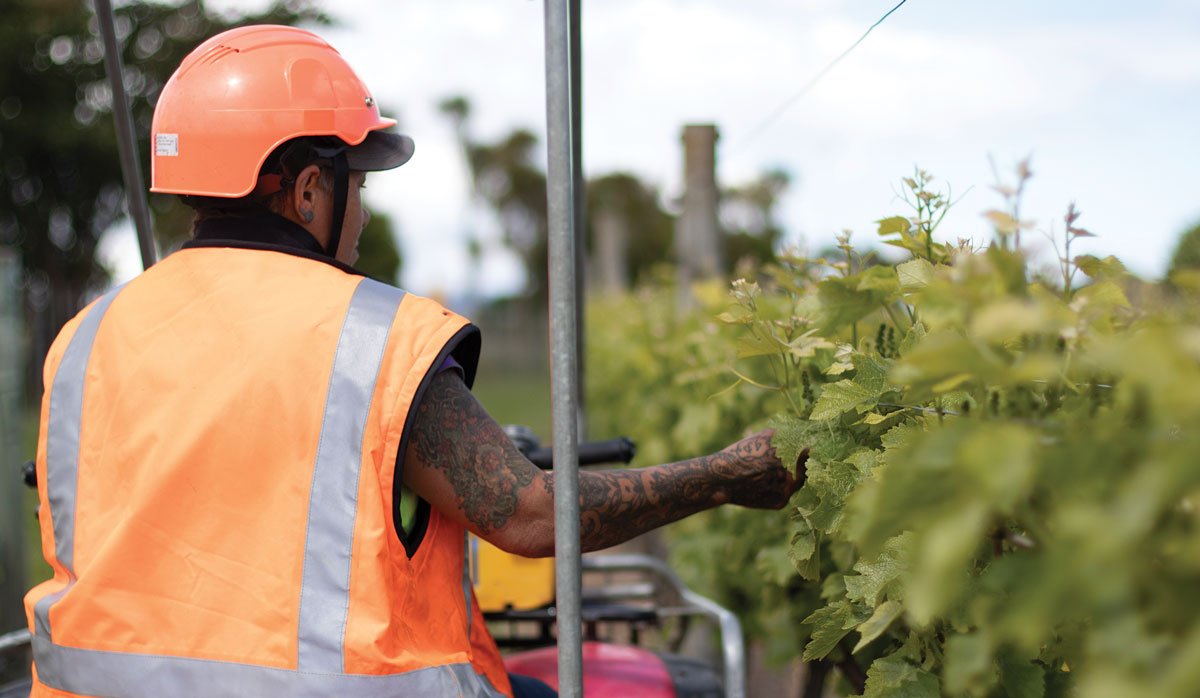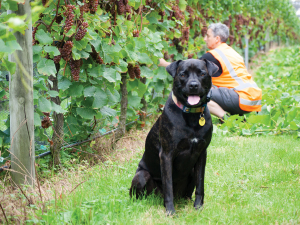"Everything we do is a bit of a risk and a bit of a challenge, and figuring thrings out for this site."
"There's just nothing normal about us," agrees Chief Executive Donna Riley, talking of bespoke solutions to growing grapes just outside Levin, from recruiting and training local labour, to navigating abundant rainfall, salty sea breezes, and fertile soil amid the gravel and boulder remnants of a glacial river.
The Horowhenua region is known for its rich Māori history, moa hunting and flax mills; for market gardens and fertile farms; and, increasingly, for real estate within commute of Wellington. These days it's also home to a 36-hectare vineyard, separated from its closest wine regions by the Cook Strait on one side and a mountain range on the other.
Ōhau Wines' story begins around 2006, with the development of a dairy farm for housing, and the desire for a green crop amid the sections, to lend the feeling of rural idyll. The developrs called on viticulturist Kate Gibbs, who has a rootstock nursery at nearby Te Horo, and she recommended fewer houses and more grapes, seeing great potential in the soil and microclimate, says Jo.
Kate recommended Pinot Noir and Pinot Gris for the first 10ha of vines, and the Gris immediately exceeded expectations, with the first vintage in 2009 winning Pinot Gris of the Show at the Bragato Wine Awards. That first Ōhau Gravels Pinot Gris was made by Jane Cooper in the Wairarapa, who remains the company's winemaker, and Ōhau continues to achieve high accolades for the variety each vintage, says Donna. "It has been a constant winner for us."
Jo says they have unique soils, thanks to the Ōhau River that once rolled through, leaving gravel and boulders and "interesting terroir" in its wake. "And we have a little microclimate here which is good for grapes."
They also have "very, very fertile land" and high rainfall, with crop levels that are somewhat "naturally equalised" by coastal winds over flowering, says Donna. "We have learned to manage our canopy to suit the vigour and the rainfall. We have to do a lot more work in the vineyard than a lot of other areas."
That workload is another sphere in which Ōhau has innovated out of necessity, with results they believe could provide a template for others in the industry. "Everyone in our vineyard team are locals," says Jo. "We didn't bring anyone in and none of them had any viticultural experience... They have all been in training since the very beginning."
When Donna joined the team in 2012, she looked at getting a pruning crew over from the Wairarapa, before travel and accommodation challenges derailed the plan. "At some stage in my very diverse career I had been a schoolteacher, so I sort of took that and looked at how we could create process to quickly onboard people, so we could get productive employees at a high skill level really quickly from the local community."
Two of their current core team were stay-at-home mums before they came to the company. Libby Brick started off weed-eating around the cellar door, as part of her job with a local gardening contractor, then moved on to pruning in winter. When her youngest child was settled at primary school, she joined the company as a causal, says Donna. "We put her through the Primary ITO programme, and now she's the vineyard manager." Another full-time employee, Gill Jamieson, did her apprenticeship in her 50s, after all her children had left home, and her son Jordan is now another full-time member of the team.
All the full-time staff are from the area and have been trained on the job, understanding the unique challenges and opportunities of the site. And come pruning season they train a team of 30 casuals. "Some of them will have been with us in previous years and some are new," says Jo, explaining that the processes they have in place mean those with no experience get trained up quickly to do the job to a good standard.
 |
|---|
|
Gill Jamieson at Ōhau Wines |
That's good for locals looking for seasonal work between other horticulture crops like strawberries and cabbages ("we have to get our pruning done before we lose people to the asparagus," says Donna) and it's good for the full-time staff, who grow skills every time they share their knowledge. "Every year they have learned more and more and more, and developed expertise on our individual site," says Jo. That's become very necessary at a vineyard isolated in its location and its issues, because no-one else faces the particular challenges they have, she adds.
And it seems the team takes the "seriously unusual" status very seriously indeed. Within the vineyard, the crew talk about "thoughtfulness" in their work with the vines, and operate under a tender loving care (TLC) programme of rainbow design. As well as numbering vineyard rows, they mark their vines using bright markers, with one of the colours of the rainbow on every fifth post. That means they can easily record the location of individual plants that look lacklustre, so they can be given some TLC, says Donna. "That's quite against the mainstream normal as well," she says. "They're our babies - every single one of them - and you want to get every plant through."
They take as much care with the place those plants grow in, always looking to "acknowledge the whenua", says Jo. That started with adding the macron - or tohutō - to their brand in 2012, and focussing on correct pronunciation. It continues with their relationship with the local iwi, and desire to celebrate the stories and history of the place they now call home. When they look to the stand of old tōtara amid the vineyard, for example, they think of Ngāti Toa rangatira Te Rauparaha, who is said to have gifted timber from the forest at Ōhau for a missionary church at Ōtaki, says Donna. They talk to cellar door visitors about the kainga that sat along the banks of the Ōhau River, and the moa - and moa hunters - that once roamed here. "It feels like a pretty special place," says Jo. "We couldn't do this without the land and the people who looked after it before we got here."



